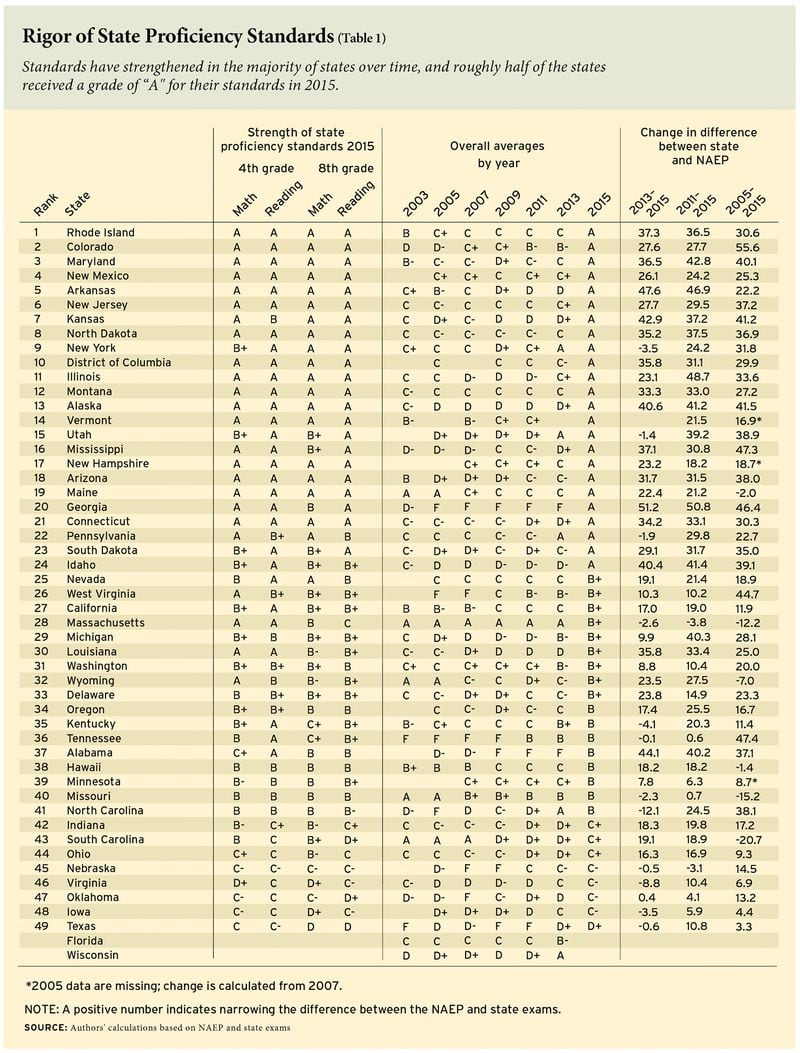Georgia saw the greatest leap in the rigor of its academic standards, jumping from F to A in its overall proficiency standards grade, according to a report released today by the journal Education Next.
Education Next evaluates the rigor of state proficiency standards against the National Assessment of Educational Progress, a federally administered benchmark test known as the Nation's Report Card. The standards are graded on an A-to-F scale based on the size of the difference between the percentages of students identified as proficient by state exams and by NAEP exams in 4th- and 8th-grade math and reading.
In past comparisons, Georgia set proficiency benchmarks far below NAEP's. In fact, Georgia had the widest point difference in the country between what score we defined as being on grade level and what NAEP required. Then, Georgia rolled out new standards and new tests; the state saw dramatic drops in performance on the Milestones last year.
Only 10 percent of Georgia students who took a language arts or science course at any grade level finished in the top category of distinguished learners. In math, 60 percent of all Georgia students scored as beginning or developing learners. At the time the scores were released, State School Superintendent Richard Woods said, "Our previous assessment, the CRCT, set some of the lowest expectations for student proficiency in the nation, and that cannot continue."
The report says there's been little movement by any states to raise proficiency thresholds -- until now. The authors cite the Common Core State Standards and federal pressure for pushing states to finally address the honesty gap in admitting how their students were really faring. Adopted by 43 states including Georgia, Common Core establishes common educational objectives and standards for assessing student proficiency in reading and math.
While only six states earned an “A” in 2005, 24 of 49 states (including the District of Columbia)—for which data were available as of mid-January 2016— earned an “A.”
Credit: Maureen Downey
Credit: Maureen Downey
Writing in Education Next, the authors of the report, Paul E. Peterson, Samuel Barrows, and Thomas Gift, state, "If Common Core works as its proponents expect, higher proficiency standards could propel schools to achieve at more impressive levels and thus raise the nation’s ranking on international tests. Of course, if parents, teachers, administrators, and policymakers do not regard the low levels of proficiency now being identified in most states as a serious warning that action is needed, then raising the proficiency bar will be for naught. Still, it is a hopeful sign that proficiency standards have moved in the right direction. If student performance shifts upward in tandem, it will signal a long-awaited enhancement in the quality of American schools. "
In speaking to Peterson on the phone, the researcher cautioned standards don't equate to performance; many students in Georgia are falling far short of the higher bar. Editor-in-chief of Education Next, Peterson is professor of government and director of the Program on Education Policy and Governance at the Harvard Kennedy School.
"Standards don’t really talk about performance at all," he said. "When you raise standards, it is going to be harder for students to meet those standards and a smaller percent of them are showing they are proficient."
Do higher standards eventually lead to higher student performance?
"Well, we don't know," said Peterson. "Europe has always had high standards but this will be an experiment for us -- whether lifting standards can actually lift achievement. We have states with high standards and achievement levels look pretty good; Massachusetts is an example. But other states have had higher standards in the past, South Carolina being one of them, and the students still are not performing at a high level."
Peterson credits Common Core for raising expectations for students and making it clear to teachers what they should be teaching. But, he says, that is only a first step. "All that has been good and they have been able to accomplish that, but we don't know whether or not that is going to be translated into the classroom," he says.
A successful translation, he says, depends a lot on teacher quality, which he considers key to improving schools. He also recommends greater school choice and sees promise in the charter school movement, which he praises for improving Washington, D.C., schools.
Among other findings by Peterson and his team:
- The average difference between the proportion of students achieving proficiency on NAEP and state tests decreased from 30 percentage points to 10 percentage points nationwide, which the authors describe as “a dramatic improvement over the previous two-year period (2011-13), in which the difference dropped only from 35 to 30 percent.”
- Twenty-four states receive a grade of “A,” indicating that they have set a proficiency bar that is roughly comparable to that set by NAEP: Alaska, Arizona, Arkansas, Colorado, Connecticut, District of Columbia, Georgia, Idaho, Illinois, Kansas, Maine, Maryland, Mississippi, Montana, New Hampshire, New Jersey, New Mexico, New York, North Dakota, Pennsylvania, Rhode Island, South Dakota, Utah, and Vermont. In 2013, nine states earned an “A,” but only New York, Pennsylvania and Utah remained in this elite group in 2015.
- Four states slipped in their proficiency standards ranking: Iowa, Kentucky, North Carolina and Virginia. Massachusetts received a ranking of B plus, lower than its previous A ranking, but this ranking is not definitive, as it is based on information from only one of the two tests that districts were allowed to administer.
- Eighteen states improved their standards by two letter grades or more since 2013: Alabama, Alaska, Arizona, Arkansas, Connecticut, District of Columbia, Georgia, Idaho, Kansas, Louisiana, Maine, Maryland, Mississippi, Montana, New Hampshire, North Dakota, Rhode Island, and South Dakota.
- Iowa, Nebraska, Oklahoma, Virginia, and Texas earned the lowest grades for the rigor of their proficiency standards. Texas was the only state to receive a D.
- Of the seven states not implementing CCSS for both reading and math, six have continued to set low proficiency standards: Indiana, C+; South Carolina, C+; Nebraska, C-; Oklahoma, C-; Virginia, C-; and Texas, D+ (Alaska, A, is the exception).
- The rise in standards between 2013 and 2015 was not concentrated in states receiving Race to the Top grants.
- Two states had yet to report test scores for 2015 at the time of the preparation of the data for this article: Florida and Wisconsin.







